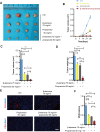Combinative effects of β-elemene and propranolol on the proliferation, migration, and angiogenesis of hemangioma
- PMID: 37456875
- PMCID: PMC10349565
- DOI: 10.7717/peerj.15643
Combinative effects of β-elemene and propranolol on the proliferation, migration, and angiogenesis of hemangioma
Abstract
Hemangioma (HA) is one of the most common benign vascular tumors among children. Propranolol is used as the first-line treatment for hemangioma and is a non-selective blocker of the β-adrenergic receptor. β-elemene is a compound extracted from Rhizoma zedoariae and has been approved for the treatment of tumors in clinical practice. However, the combinatorial effects of β-elemene and propranolol in the treatment of HA remains unclear. This study explored the combinative effects and mechanisms of β-elemene and propranolol using hemangioma-derived endothelial cells (HemECs). Cytotoxic assays showed that the combinatorial treatment of β-elemene and propranolol did not increase the cytotoxic effects of HemECs. Furthermore, functional analysis showed that the combinatorial treatment with β-elemene and propranolol significantly inhibited the proliferation, migration, and tube formation of the HemECs compared to the single treatment regimens. Mechanistic analysis showed that combinative treatment with β-elemene and propranolol synergistically down-regulated the hypoxia-inducible factor-1 alpha/vascular endothelial growth factor-A (HIF-1-α/VEGFA) signaling pathway. Additionally, in a xenograft tumor model, angiogenesis in the combinatorial treatment group was significantly lower than in the control, propranolol, and β-elemene treatment alone groups. Our results suggest that β-elemene combined with propranolol can significantly inhibit the proliferation, migration, and tube formation of HemECs via synergistically down-regulating the HIF-1-α/VEGFA signaling pathway without increasing any cytotoxic side effects.
Keywords: Angiogenesis; Hemangioma; Proliferation; Propranolol; β-elemene.
©2023 Wang et al.
Conflict of interest statement
The authors declare there are no competing interests.
Figures







Similar articles
-
β-elemene affects angiogenesis of infantile hemangioma by regulating angiotensin-converting enzyme 2 and hypoxia-inducible factor-1 alpha.J Nat Med. 2021 Jun;75(3):655-663. doi: 10.1007/s11418-021-01516-y. Epub 2021 Apr 16. J Nat Med. 2021. PMID: 33861415
-
Propranolol induces regression of hemangioma cells via the down-regulation of the PI3K/Akt/eNOS/VEGF pathway.Pediatr Blood Cancer. 2015 Aug;62(8):1414-20. doi: 10.1002/pbc.25453. Epub 2015 Mar 1. Pediatr Blood Cancer. 2015. PMID: 25728347
-
Propranolol inhibits proliferation and invasion of hemangioma-derived endothelial cells by suppressing the DLL4/Notch1/Akt pathway.Chem Biol Interact. 2018 Oct 1;294:28-33. doi: 10.1016/j.cbi.2018.08.018. Epub 2018 Aug 18. Chem Biol Interact. 2018. PMID: 30130526
-
Propranolol Therapy in Infantile Hemangioma: It Is Not Just About the Beta.Plast Reconstr Surg. 2021 Apr 1;147(4):875-885. doi: 10.1097/PRS.0000000000007699. Plast Reconstr Surg. 2021. PMID: 33776033
-
Hemangioma Endothelial Cells and Hemangioma Stem Cells in Infantile Hemangioma.Ann Plast Surg. 2022 Feb 1;88(2):244-249. doi: 10.1097/SAP.0000000000002835. Ann Plast Surg. 2022. PMID: 35023872 Review.
Cited by
-
Bioadhesive Eudragit RL®100 Nanocapsules for Melanoma Therapy: A Repurposing Strategy for Propranolol.Pharmaceutics. 2025 May 29;17(6):718. doi: 10.3390/pharmaceutics17060718. Pharmaceutics. 2025. PMID: 40574031 Free PMC article.
References
-
- Chen P, Li X, Zhang R, Liu S, Xiang Y, Zhang M, Chen X, Pan T, Yan L, Feng J, Duan T, Wang D, Chen B, Jin T, Wang W, Chen L, Huang X, Zhang W, Sun Y, Li G, Kong L, Chen X, Li Y, Yang Z, Zhang Q, Zhuo L, Sui X, Xie T. Combinative treatment of beta-elemene and cetuximab is sensitive to KRAS mutant colorectal cancer cells by inducing ferroptosis and inhibiting epithelial-mesenchymal transformation. Theranostics. 2020;10:5107–5119. doi: 10.7150/thno.44705. - DOI - PMC - PubMed
MeSH terms
Substances
Associated data
LinkOut - more resources
Full Text Sources
Medical

